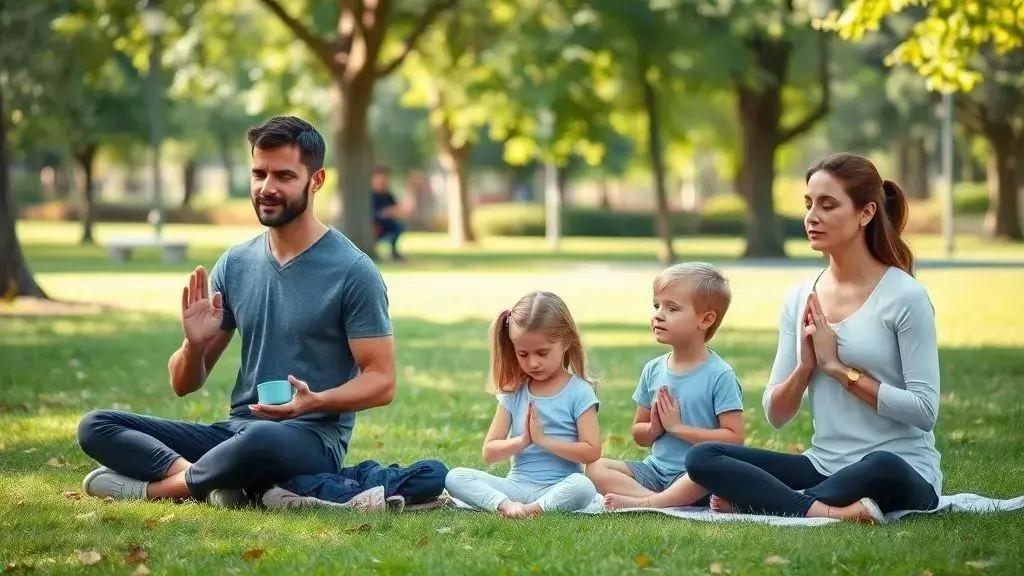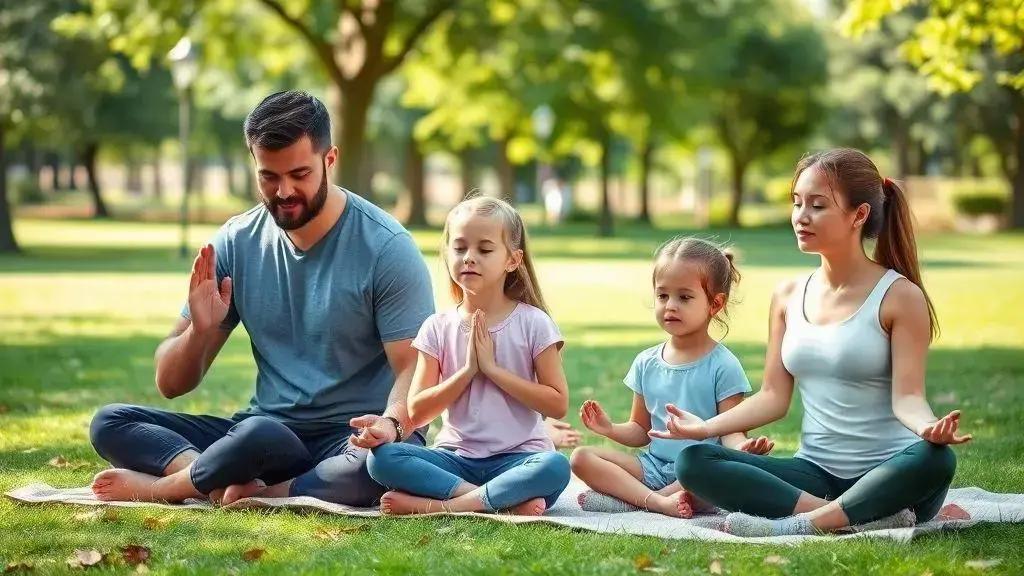Mindfulness practices for parents and children: a guide

Mindfulness practices for parents and children enhance emotional well-being, improve communication, and foster stronger family connections through simple exercises and a supportive home environment.
Mindfulness practices for parents and children offer a wonderful opportunity to strengthen family connections. Have you ever thought about how spending a few moments being present together can transform your family’s dynamics? Let’s delve into the various ways these practices can enhance your daily life.
Understanding mindfulness for families
Understanding mindfulness for families is essential for building strong connections. This practice encourages everyone to be present in the moment, helping family members support one another.
By practicing mindfulness together, families can create a nurturing environment where communication flows more easily. Mindfulness can reduce stress and increase feelings of happiness within the home.
What is Mindfulness?
Mindfulness means being fully aware of what’s happening right now. Instead of getting lost in worries about the past or future, families can enjoy the present moment.
Benefits of Mindfulness for Families
- Enhances emotional well-being.
- Improves communication skills.
- Promotes empathy among family members.
- Reduces stress and anxiety.
As families take time to practice mindfulness, they can build deeper relationships. Simple activities like breathing exercises or mindful walks can make a significant difference.
In addition, focusing on each other’s feelings can lead to better parenting. When parents model mindfulness, children learn to manage their emotions effectively. This creates a calm atmosphere where everyone feels valued.
Getting Started with Mindfulness
Starting a mindfulness practice requires just a few simple steps. Setting aside time each day for family mindfulness activities can have lasting effects.
- Find a quiet space at home.
- Choose a time that works for everyone.
- Engage in activities like deep breathing or meditation.
Remember, the goal is to be present and enjoy the moment together. As families continue to explore mindfulness, they’ll find new ways to connect and grow.
Benefits of mindfulness for parents and children

The benefits of mindfulness for parents and children are vast and impactful. This practice can significantly improve the overall well-being of families. By incorporating mindfulness into daily routines, both parents and children can experience positive changes in their relationships and emotional health.
Mindfulness fosters an atmosphere of open communication. When families practice being present with each other, they promote understanding and empathy. This leads to stronger bonds and a supportive environment.
Emotional Regulation
One of the main benefits is enhanced emotional regulation. Learning to be mindful helps children recognize and manage their feelings. Parents can model this behavior, showing their kids how to cope with stress and anxiety.
Improved Focus
Another advantage is improved focus and concentration. Mindfulness exercises encourage children to stay present, which can enhance their attention span and academic performance. For parents, this means being more engaged in activities while spending quality time together.
- Reduces stress and anxiety levels.
- Encourages a positive attitude toward challenges.
- Promotes resilience in children.
- Improves parent-child communication.
Practicing mindfulness as a family can also lead to greater resilience. Children learn to bounce back from disappointments, while parents can support them in developing problem-solving skills.
Through mindfulness, families create habits that nurture well-being. Regular practice brings moments of joy and connection, making everyday life more enjoyable. As parents and children grow together in their mindfulness journey, they cultivate a sense of community and love that enriches their lives.
Simple mindfulness exercises to try together
Simple mindfulness exercises to try together can strengthen family bonds and create a peaceful atmosphere at home. These activities are easy to do and can fit into your daily routine. The beauty of these exercises is that they require no special equipment or long time commitments.
One effective exercise is the 5-4-3-2-1 technique. This practice helps everyone focus on their surroundings by identifying:
- 5 things they can see.
- 4 things they can touch.
- 3 things they can hear.
- 2 things they can smell.
- 1 thing they can taste.
This technique encourages children to become aware of the present moment while parents lead by example. Another enjoyable exercise is mindful breathing. Families can sit together, close their eyes, and take slow, deep breaths. Inhale for four counts, hold for four counts, and exhale for four counts. This can calm restless minds and foster connection.
Mindful Walks
Going on a mindful walk is also a fun way to practice mindfulness. While walking in a park or neighborhood, encourage family members to pay attention to the sights, sounds, and smells around them. This shared experience can bring conversations about nature and feelings, reinforcing mindfulness.
Gratitude Journals
Another simple exercise involves keeping gratitude journals. Each family member can write down three things they are grateful for each day. This practice shifts focus from stress to positivity, helping everyone appreciate the little joys in life.
Implementing these exercises regularly can enhance emotional well-being and communication within the family. As these mindfulness practices become part of daily life, families will find it easier to connect and support one another during challenging times.
Creating a mindful home environment

Creating a mindful home environment is essential for fostering peace and connection among family members. A home that encourages mindfulness allows everyone to feel safe, respected, and understood. Simple changes can make a big difference.
Start by designating a calm area in the home. This space can be small yet cozy, filled with comfortable cushions, soft lighting, and calming decorations. Establishing a specific area for mindfulness practices invites family members to gather and embrace these moments together.
Decluttering Your Space
Another important step is decluttering. A tidy environment reduces distractions and promotes focus. Encourage everyone to participate in cleaning up their spaces and choosing which items are truly meaningful to them. This not only creates a more peaceful setting but also allows children to learn responsibility.
Incorporating Nature
Bringing elements of nature inside can enhance your mindful home. Plants, flowers, and natural materials create a soothing atmosphere. Encourage your family to care for these plants together, teaching children to appreciate nature’s beauty and its calming effects.
- Use scents like lavender or eucalyptus to create relaxation.
- Play soft music to set a tranquil vibe.
- Incorporate artwork that inspires peace and positivity.
Mindfulness rituals can be integrated into daily routines. Begin meals with a moment of gratitude or establish a regular family mindfulness session each week. Such rituals strengthen bonds and encourage everyone to practice being present.
Lastly, open communication is crucial. Foster an environment where everyone feels comfortable sharing their thoughts and emotions. This openness promotes understanding and collaboration, making it easier for family members to support one another.
FAQ – Frequently Asked Questions about Mindfulness Practices for Parents and Children
What are some simple mindfulness exercises I can do with my children?
You can practice mindfulness together through techniques like the 5-4-3-2-1 method or mindful breathing exercises.
How can I create a mindful environment at home?
Designate a calm space for mindfulness, declutter, incorporate nature, and establish regular mindfulness rituals.
What are the emotional benefits of mindfulness for families?
Mindfulness helps reduce stress, improves communication, and enhances emotional regulation among family members.
How can mindfulness improve my child’s focus?
Mindfulness practices encourage present-moment awareness, which can enhance attention spans and concentration in children.





